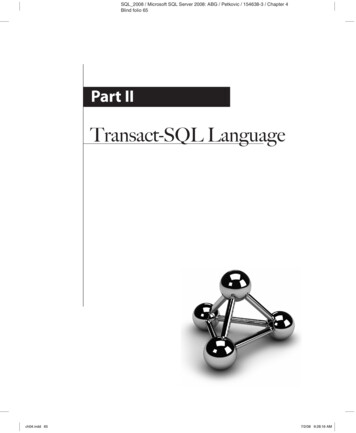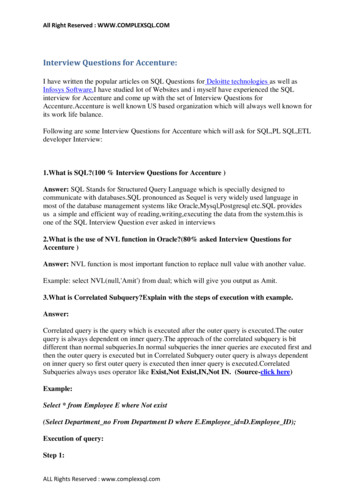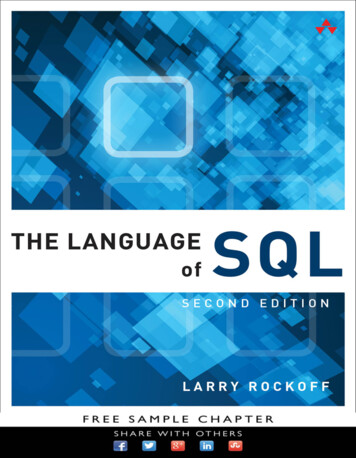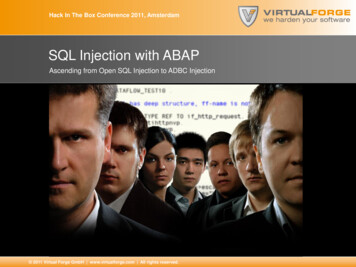
Transcription
SQL 2008 / Microsoft SQL Server 2008: ABG / Petkovic / 154638-3 / Chapter 4Blind folio 65Part #IITransact-SQL Languagech04.indd 657/2/08 9:28:16 AM
SQL 2008 / Microsoft SQL Server 2008: ABG / Petkovic / 154638-3 / Chapter 4Blind folio 66ch04.indd 667/2/08 9:28:16 AM
SQL 2008 / Microsoft SQL Server 2008: ABG / Petkovic / 154638-3 / Chapter 4Chapter 4SQL ComponentsIn This Chaptercccccch04.indd 67SQL’s Basic ObjectsData TypesTransact-SQL FunctionsScalar OperatorsNULL Values7/2/08 9:28:16 AM
SQL 2008 / Microsoft SQL Server 2008: ABG / Petkovic / 154638-3 / Chapter 468M i c r o s o f t S Q L S e r v e r 2 0 0 8 : A B e g i n n e r ’s G u i d eThis chapter introduces the elementary objects and basic operators supportedby the Transact-SQL language. First, the basic language elements, includingconstants, identifiers, and delimiters, are described. Then, because everyelementary object has a corresponding data type, data types are discussed in detail.Additionally, all existing operators and functions are explained. At the end of thechapter, NULL values are introduced.SQL’s Basic ObjectsThe language of Database Engine, Transact-SQL, has the same basic features as othercommon programming languages:cccccLiteral values (also called constants)DelimitersCommentsIdentifiersReserved keywordsThe following sections describe these features.Literal ValuesA literal value is an alphanumerical, hexadecimal, or numeric constant. A stringconstant contains one or more characters of the character set enclosed in two singlestraight quotation marks (' ') or double straight quotation marks (" ") (single quotationmarks are preferred due to the multiple uses of double quotation marks, as discussedin a moment). If you want to include a single quotation mark within a string delimitedby single quotation marks, use two consecutive single quotation marks within thestring. Hexadecimal constants are used to represent nonprintable characters and otherbinary data. Each hexadecimal constant begins with the characters '0x' followed by aneven number of characters or numbers. Examples 4.1 and 4.2 illustrate some valid andinvalid string constants and hexadecimal constants.Example 4.1Some valid string constants and hexadecimal constants follow:'Philadelphia'"Berkeley, CA 94710"'9876''Apostrophe is displayed like this: can''t' (note the two consecutive single quotation marks)0x53514C0Dch04.indd 687/2/08 9:28:16 AM
SQL 2008 / Microsoft SQL Server 2008: ABG / Petkovic / 154638-3 / Chapter 4Chapter 4: SQL Components69Example 4.2The following are not string constants:'AB'C' (odd number of single quotation marks)'New York" (same type of quotation mark—single or double—must be used at eachend of the string)The numeric constants include all integer, fixed-point, and floating-point values withand without signs (see Example 4.3).Example 4.3The following are numeric constants:130–130.00–0.357E5 (scientific notation—nEm means n multiplied by 10m)22.3E-3A constant always has a data type and a length, and both depend on the format of theconstant. Additionally, every numeric constant has a precision and a scale factor. (Thedata types of the different kinds of literal values are explained later in this chapter.)DelimitersIn Transact-SQL, double quotation marks have two meanings. In addition to enclosingstrings, double quotation marks can also be used as delimiters for so-called delimitedidentifiers. Delimited identifiers are a special kind of identifier usually used to allow theuse of reserved keywords as identifiers and also to allow spaces in the names of databaseobjects.NoteDifferentiation between single and double quotation marks was first introduced in the SQL92 standard. In thecase of identifiers, this standard differentiates between regular and delimited identifiers. Two key differencesare that delimited identifiers are enclosed in double quotation marks and are case sensitive. (Transact-SQL alsosupports the use of square brackets instead of double quotation marks.) Double quotation marks are only usedfor delimiting strings. Generally, delimited identifiers were introduced to allow the specification of identifiers,which are otherwise identical to reserved keywords. Specifically, delimited identifiers protect you from usingnames (identifiers, variable names) that could be introduced as reserved keywords in one of the future SQLstandards. Also, delimited identifiers may contain characters that are normally illegal within identifier names,such as blanks.ch04.indd 697/2/08 9:28:16 AM
SQL 2008 / Microsoft SQL Server 2008: ABG / Petkovic / 154638-3 / Chapter 470M i c r o s o f t S Q L S e r v e r 2 0 0 8 : A B e g i n n e r ’s G u i d eIn Transact-SQL, the use of double quotation marks is defined using the QUOTEDIDENTIFIER option of the SET statement. If this option is set to ON, which is thedefault value, an identifier in double quotation marks will be defined as a delimitedidentifier. In this case, double quotation marks cannot be used for delimiting strings.CommentsThere are two different ways to specify a comment in a Transact-SQL statement. Usingthe pair of characters /* and */ marks the enclosed text as a comment. In this case, thecomment may extend over several lines. Furthermore, the characters -- (two hyphens)indicate that the remainder of the current line is a comment. (The two hyphens -- complywith the ANSI SQL standard, while /* and */ are the extensions of Transact-SQL.)IdentifiersIn Transact-SQL, identifiers are used to identify database objects such as databases,tables, and indices. They are represented by character strings that may include up to 128characters and can contain letters, numerals, or the following characters: , @, #, and .Each name must begin with a letter or one of the following characters: , @, or #. Thecharacter # at the beginning of a table or stored procedure name denotes a temporaryobject, while @ at the beginning of a name denotes a variable. As indicated earlier, theserules don’t apply to delimited identifiers (also known as quoted identifiers), which cancontain, or begin with, any character (other than the delimiters themselves).Reserved KeywordsEach programming language has a set of names with reserved meanings, which must bewritten and used in the defined format. Names of this kind are called reserved keywords.Transact-SQL uses a variety of such names, which, as in many other programminglanguages, cannot be used as object names, unless the objects are specified as delimitedor quoted identifiers.NoteIn Transact-SQL, the names of all data types and system functions, such as CHARACTER and INTEGER, are notreserved keywords. They can therefore be used for denoting objects. (Do not use data types and system functionsas object names! Such a use makes Transact-SQL statements difficult to read and understand.)ch04.indd 707/2/08 9:28:16 AM
SQL 2008 / Microsoft SQL Server 2008: ABG / Petkovic / 154638-3 / Chapter 4Chapter 4: SQL Components71Data TypesAll the data values of a column must be of the same data type. (The only exceptionspecifies the values of the SQL VARIANT data type.) Transact-SQL uses differentdata types, which can be categorized as follows:cccccNumeric data typesCharacter data typesTemporal (date and/or time) data typesMiscellaneous data typesDECIMAL with VARDECIMAL storage typeThe following sections describe all these categories.Numeric Data TypesNumeric data types are used to represent numbers. The following table shows the list ofall numeric data types:ch04.indd 71Data TypeExplanationINTEGERRepresents integer values that can be stored in 4 bytes. The range of values is –2,147,483,648 to2,147,483,647. INT is the short form for INTEGER.SMALLINTRepresents integer values that can be stored in 2 bytes. The range of values is –32768 to 32767.TINYINTRepresents nonnegative integer values that can be stored in 1 byte. The range of values is 0 to 255.BIGINTRepresents integer values that can be stored in 8 bytes. The range of values is –263 to 263 – 1.DECIMAL(p,[s])Describes fixed-point values. The argument p (precision) specifies the total number of digits withassumed decimal point s (scale) digits from the right. DECIMAL values are stored, depending on thevalue of p, in 5 to 17 bytes. DEC is the short form for DECIMAL.NUMERIC(p,[s])Synonym for DECIMAL.REALUsed for floating-point values. The range of positive values is approximately 2.23E – 308 to 1.79E 308, and the range of negative values is approximately –1.18E – 38 to –1.18E 38 (the value zerocan also be stored).FLOAT[(p)]Represents floating-point values, like REAL. p defines the precision with p 25 as single precision(4 byte) and p 25 as double precision (8 byte).MONEYUsed for representing monetary values. MONEY values correspond to 8-byte DECIMAL values andare rounded to four digits after the decimal point.SMALLMONEYCorresponds to the data type MONEY but is stored in 4 bytes.7/2/08 9:28:17 AM
SQL 2008 / Microsoft SQL Server 2008: ABG / Petkovic / 154638-3 / Chapter 472M i c r o s o f t S Q L S e r v e r 2 0 0 8 : A B e g i n n e r ’s G u i d eCharacter Data TypesThere are two general forms of character data types. They can be strings of single-bytecharacters or strings of Unicode characters. (Unicode uses several bytes to specify onecharacter.) Further, strings can have fixed or variable length. The following characterdata types are used:Data TypeExplanationCHAR[(n)]Represents a fixed-length string of single-byte characters, where n is the number of charactersinside the string. The maximum value of n is 8000. CHARACTER(n) is an additional equivalent formfor CHAR(n). If n is omitted, the length of the string is assumed to be 1.VARCHAR[(n)]Describes a variable-length string of single-byte characters (0 n 8000). In contrast to the CHARdata type, the values for the VARCHAR data type are stored in their actual length. This data type hastwo synonyms: CHAR VARYING and CHARACTER VARYING.NCHAR[(n)]Stores fixed-length strings of Unicode characters. The main difference between the CHAR and NCHARdata types is that each character of the NCHAR data type is stored in 2 bytes, while each character ofthe CHAR data type uses 1 byte of storage space. Therefore, the maximum number of characters in acolumn of the NCHAR data type is 4000.NVARCHAR[(n)]Stores variable-length strings of Unicode characters. The main difference between the VARCHAR andthe NVARCHAR data types is that each NVARCHAR character is stored in 2 bytes, while each VARCHARcharacter uses 1 byte of storage space. The maximum number of characters in a column of theNVARCHAR data type is 4000.NoteThe VARCHAR data type is identical to the CHAR data type except for one difference: if the content of a CHAR(n)string is shorter than n characters, the rest of the string is padded with blanks. (A value of the VARCHAR datatype is always stored in its actual length.)Temporal Data TypesTransact-SQL supports the following temporal data types:ccccccch04.indd FSET7/2/08 9:28:17 AM
SQL 2008 / Microsoft SQL Server 2008: ABG / Petkovic / 154638-3 / Chapter 4Chapter 4: SQL Components73The DATETIME and SMALLDATETIME data types specify a date and time,with each value being stored as an integer value in 4 bytes or 2 bytes, respectively.Values of DATETIME and SMALLDATETIME are stored internally as two separatenumeric values. The date value of DATETIME is stored in the range 01/01/1753to 12/31/9999. The analog value of SMALLDATETIME is stored in the range01/01/1900 to 06/06/2079. The time component is stored in the second 4-byte(or 2-byte for SMALLDATETIME) field as the number of three-hundredths of a second(DATETIME) or minutes (SMALLDATETIME) that have passed since midnight.The use of DATETIME and SMALLDATETIME is rather inconvenient ifyou want to store only the date part or time part. For this reason, SQL Server 2008introduces the new data types DATE and TIME, which store just the DATE or TIMEcomponent of a DATETIME, respectively. The DATE data type is stored in 3 bytesand has the range 01/01/0001 to 12/31/9999. The TIME data type is stored in 3–5bytes and has an accuracy of 100 nanoseconds (ns).The DATETIME2 data type is also a new data type that stores high-precision dateand time data. The data type can be defined for variable lengths depending on therequirement. (The storage size is 6–8 bytes). The accuracy of the time part is 100 ns.This data type isn’t aware of Daylight Saving Time.All the temporal data types described thus far don’t have support for the time zone.The new data type called DATETIMEOFFSET has the time zone offset portion. Forthis reason, it is stored in 6–8 bytes. (All other properties of this data type are analogousto the corresponding properties of DATETIME2.)The date value in Transact-SQL is by default specified as a string in a formatlike 'mmm dd yyyy' (e.g., 'Jan 10 1993') inside two single quotation marks or doublequotation marks. (Note that the relative order of month, day, and year can be controlledby the SET DATEFORMAT statement. Additionally, the system recognizes numericmonth values with delimiters of / or –.) Similarly, the time value is specified in theformat 'hh:mm' and Database Engine uses 24-hour time (23:24, for instance).NoteTransact-SQL supports a variety of input formats for datetime values. As you already know, both objects areidentified separately; thus, date and time values can be specified in any order or alone. If one of the values isomitted, the system uses the default values. (The default value for time is 12:00 AM.)Examples 4.4 and 4.5 show the different ways, how date or time values can bewritten using the different formats.Example 4.4The following date descriptions can be used:'28/5/1959' (with SET DATEFORMAT dmy)'May 28, 1959''1959 MAY 28'ch04.indd 737/2/08 9:28:17 AM
SQL 2008 / Microsoft SQL Server 2008: ABG / Petkovic / 154638-3 / Chapter 474M i c r o s o f t S Q L S e r v e r 2 0 0 8 : A B e g i n n e r ’s G u i d eExample 4.5The following time expressions can be used:'8:45 AM''4 pm'Miscellaneous Data TypesTransact-SQL supports several data types that do not belong to any of the data typegroups described previously:ccccccccccccBinary data typesBITLarge object data typesCURSOR (discussed in Chapter 8)UNIQUEIDENTIFIERSQL VARIANTTABLE (discussed in Chapter 8)XML (discussed in Chapter 28)Spatial (e.g., GEOGRAPHY and GEOMETRY) data types (discussed inChapter 29 )HIERARCHYIDTIMESTAMP data typeUser-defined data types (discussed in Chapter 5)The following sections describe each of these data types (other than those designatedas being discussed in another chapter).Binary and BIT Data TypesBINARY and VARBINARY are the two binary data types. They describe data objectsbeing represented in the internal format of the system. They are used to store bitstrings. For this reason, the values are entered using hexadecimal numbers.The values of the BIT data type are stored in a single bit. Therefore, up to 8 bitcolumns are stored in 1 byte. The following table summarizes the properties of thesedata types:ch04.indd 747/2/08 9:28:17 AM
SQL 2008 / Microsoft SQL Server 2008: ABG / Petkovic / 154638-3 / Chapter 4Chapter 4: SQL ComponentsData TypeExplanationBINARY[(n)]Specifies a bit string of fixed length with exactly n bytes (0 n 8000).VARBINARY[(n)]Specifies a bit string of variable length with up to n bytes (0 n 8000).BITUsed for specifying the Boolean data type with three possible values: FALSE, TRUE, and NULL.75Large Object Data TypesLarge objects (LOBs) are data objects with the maximum length of 2GB. These objectsare generally used to store large text data and to load modules and audio/video files.Transact-SQL supports two different ways to specify and access LOBs:ccUse the data types VARCHAR(MAX), NVARCHAR(MAX), andVARBINARY(MAX)Use the so-called text/image data typeThe following subsections describe the two forms of LOBs.The MAX Specifier Starting with SQL Server 2005, you can use the same programmingmodel to access values of standard data types and LOBs. In other words, you can useconvenient system functions and string operators to work with LOBs.Database Engine uses the MAX specifier with the data types VARCHAR,NVARCHAR, and VARBINARY to define variable-length columns. When you useMAX by default (instead of an explicit value), the system analyzes the length of theparticular string and decides whether to store the string as a convenient value or asa LOB. The MAX specifier indicates that the size of column values can reach themaximum LOB size of the current system. (In a future version of SQL Server, it ispossible that MAX will have a higher maximum value for strings.)Although the database system decides how a LOB will be stored, you can overridethis default specification using the sp tableoption system procedure with the LARGEVALUE TYPES OUT OF ROW option. If the option’s value is set to 1, the data incolumns declared using the MAX specifier will be stored separately from all other data.If this option is set to 0, Database Engine stores all values for the row size 8060 bytesas regular row data.In SQL Server 2008, you can apply the new FILESTREAM attribute to aVARBINARY(MAX) column to store large binary data directly in an NTFS filesystem. The main advantage of this attribute is that the size of the corresponding LOBis limited only by the file system volume size.ch04.indd 757/2/08 9:28:17 AM
SQL 2008 / Microsoft SQL Server 2008: ABG / Petkovic / 154638-3 / Chapter 476M i c r o s o f t S Q L S e r v e r 2 0 0 8 : A B e g i n n e r ’s G u i d eTEXT, NTEXT, and IMAGE Data Types The data types TEXT, NTEXT, and IMAGEconstitute the so-called text/image data types. Data objects of the type IMAGE cancontain any kind of data (load modules, audio/video), while data objects of the datatypes TEXT and NTEXT can contain any text data (that is, printable data).The text/image data types are stored by default separately from all other values of adatabase using a B-tree structure that points to the fragments of that data. (A B-treestructure is a treelike data structure in which all of the bottom nodes are the same numberof levels away from the root of the tree.) For columns of a text /image data type, DatabaseEngine stores a 16-byte pointer in the data row that specifies where the data can be found.If the amount of text/image data is less than 32KB, the pointer points to the rootnode of the B-tree structure, which is 84 bytes long. The root node points to thephysical blocks of the data. If the amount of the data is greater than 32KB, DatabaseEngine builds intermediate nodes between the data blocks and the root node.For each table that contains more than one column with such data, all values of thecolumns are stored together. However, one physical page can hold only text/image datafrom a single table.Although text/image data is stored separately from all other data, you can modifythis using the sp tableoption system procedure with the TEXT IN ROW option.Using this option, you can specify the maximum number of bytes, which are storedtogether with the regular data.The text/image data types discussed this far have several limitations. You can’t usethem as local variables (in stored procedures or in groups of Transact-SQL statements).Also, they can’t be a part of an index or can’t be used in the following clauses ofthe SELECT statement: WHERE, ORDER BY, and GROUP BY. The biggestproblem concerning all text/image data types is that you have to use special operators(READTEXT, WRITETEXT, and UPDATETEXT) to work with such data.NoteThe text/image data types are marked as a deprecated feature and will be removed in a future version ofDatabase Engine. Use VARCHAR(MAX), NVARCHAR(MAX), and VARBINARY(MAX) instead.UNIQUEIDENTIFIER Data TypeAs its name implies, a value of the UNIQUEIDENTIFIER data type is a uniqueidentification number stored as a 16-byte binary string. This data type is closely related tothe globally unique identifier (GUID), which guarantees uniqueness worldwide. Hence,using this data type, you can uniquely identify data and objects in distributed systems.The initialization of a column or a variable of the UNIQUEIDENTIFIER type canbe provided using the functions NEWID and NEWSEQUENTIALID, as well as withch04.indd 767/2/08 9:28:17 AM
SQL 2008 / Microsoft SQL Server 2008: ABG / Petkovic / 154638-3 / Chapter 4Chapter 4: SQL Components77a string constant written in a special form using hexadecimal digits and hyphens. (Thefunctions NEWID and NEWSEQUENTIALID are described in the section “SystemFunctions” later in this chapter.)A column of the UNIQUEIDENTIFIER data type can be referenced using thekeyword ROWGUIDCOL in a query to specify that the column contains ID values.(This keyword does not generate any values.) A table can have several columns of theUNIQUEIDENTIFIER type, but only one of them can have the ROWGUIDCOLkeyword.SQL VARIANT Data TypeThe SQL VARIANT data type can be used to store values of various data types at thesame time, such as numeric values, strings, and date values. (The only types of valuesthat cannot be stored are TIMESTAMP values.) Each value of an SQL VARIANTcolumn has two parts: the data value and the information that describes the value. (Thisinformation contains all properties of the actual data type of the value, such as length,scale, and precision.)Transact-SQL supports the SQL VARIANT PROPERTY function, whichdisplays the attached information for each value of an SQL VARIANT column. Forthe use of the SQL VARIANT data type, see Example 5.5 in Chapter 5.NoteDeclare a column of a table using the SQL VARIANT data type only if it is really necessary. A column shouldhave this data type if its values may be of different types or if it is not possible to determine the type of a columnduring the database design process.HIERARCHYID Data TypeThe HIERARCHYID data type is used to store an entire hierarchy. It is implementedas a Common Language Runtime (CLR) user-defined type that comprises severalsystem functions for creating and operating on hierarchy nodes. The followingfunctions, among others, belong to the methods of this data type: GetAncestor(),GetDescendant(), Read(), and Write(). (The detailed description of this data type isoutside the scope of this book.)TIMESTAMP Data TypeThe TIMESTAMP data type specifies a column being defined as VARBINARY(8) orBINARY(8), depending on nullability of the column. The system maintains a currentvalue (not a date or time) for each database, which it increments whenever any row withch04.indd 777/2/08 9:28:17 AM
SQL 2008 / Microsoft SQL Server 2008: ABG / Petkovic / 154638-3 / Chapter 478M i c r o s o f t S Q L S e r v e r 2 0 0 8 : A B e g i n n e r ’s G u i d ea TIMESTAMP column is inserted or updated and sets the TIMESTAMP columnto that value. Thus, TIMESTAMP columns can be used to determine the relative timewhen rows were last changed. (ROWVERSION is a synonym for TIMESTAMP.)NoteThe value stored in a TIMESTAMP column isn’t important by itself. This column is usually used to detect whether aspecific row has been changed since the last time it was accessed.DECIMAL with VARDECIMAL Storage FormatThe DECIMAL data type is typically stored on the disk as fixed-length data. SinceSQL Server 2005 SP2, this data type can be stored as a variable-length column byusing the new storage format called VARDECIMAL. Using VARDECIMAL, you cansignificantly reduce the storage space for a DECIMAL column in which values havesignificant difference in their lengths.NoteVARDECIMAL is a storage format and not a data type.The VARDECIMAL storage format is helpful when you have to specify the largestpossible value for a field in which the stored values usually are much smaller. Table 4-1shows this.NoteThe VARDECIMAL storage format works the same way for the DECIMAL data type as the VARCHAR data typeworks for alphanumerical data.PrecisionNo. of Bytes: VARDECIMALNo. of Bytes: Fixed Length0 or NULL25145201213301617382017Table 4-1ch04.indd 78Number of Bytes for Storing VARDECIMAL and Fixed Length7/2/08 9:28:17 AM
SQL 2008 / Microsoft SQL Server 2008: ABG / Petkovic / 154638-3 / Chapter 4Chapter 4: SQL Components79To enable the VARDECIMAL storage format, you first have to enable it for thedatabase and then enable it for the particular table of that database. The sp dbvardecimal storage format system procedure is used for the first step, as Example 4.6shows.Example 4.6EXEC sp db vardecimal storage format 'sample', 'ON';The VARDECIMAL STORAGE FORMAT option of the sp table optionsystem procedure is used to turn on this storage for the table. Example 4.7 turns on theVARDECIMAL storage format for the project table.Example 4.7EXEC sp tableoption 'project', 'vardecimal storage format', 1As you already know, the main reason to use the VARDECIMAL storage format isto reduce the storage size of the data. If you want to test how much storage space couldbe gained by using this storage format, use the dynamic management view calledsys.sp estimated rowsize reduction for vardecimal. This dynamic managementview gives you a detailed estimate for the particular table.Transact-SQL FunctionsTransact-SQL functions can be either aggregate functions or scalar functions. Thefollowing sections describe these function types.Aggregate FunctionsAggregate functions are applied to a group of data values from a column. Aggregatefunctions always return a single value. Transact-SQL supports several groups ofaggregate functions:ccccch04.indd 79Convenient aggregate functionsStatistical aggregate functionsUser-defined aggregate functionsAnalytic aggregate functions7/2/08 9:28:17 AM
SQL 2008 / Microsoft SQL Server 2008: ABG / Petkovic / 154638-3 / Chapter 480M i c r o s o f t S Q L S e r v e r 2 0 0 8 : A B e g i n n e r ’s G u i d eStatistical and analytic aggregates are discussed in Chapter 24. User-definedaggregates are beyond the scope of this book. That leaves the convenient aggregatefunctions, described next:cccccAVG Calculates the arithmetic mean (average) of the data values containedwithin a column. The column must contain numeric values.MAX and MIN Calculate the maximum and minimum data value of thecolumn, respectively. The column can contain numeric, string, and date/timevalues.SUM Calculates the total of all data values in a column. The column mustcontain numeric values.COUNT Calculates the number of (non-null) data values in a column. Theonly aggregate function not being applied to columns is COUNT(*). This functionreturns the number of rows (whether or not particular columns have NULLvalues).COUNT BIG Analogous to COUNT, the only difference beingthat COUNT BIG returns a value of the BIGINT data type.The use of convenient aggregate functions with the SELECT statement aredescribed in detail in Chapter 6.Scalar FunctionsIn addition to aggregate functions, Transact-SQL provides several scalar functions thatare used in the construction of scalar expressions. (A scalar function operates on a singlevalue or list of values, as opposed to aggregate functions, which operate on the datafrom multiple rows.) Scalar functions can be categorized as follows:cccccNumeric functionsDate functionsString functionsSystem functionsMetadata functionsThe following sections describe these function types.ch04.indd 807/2/08 9:28:17 AM
SQL 2008 / Microsoft SQL Server 2008: ABG / Petkovic / 154638-3 / Chapter 4Chapter 4: SQL Components81Numeric FunctionsNumeric functions within Transact-SQL are mathematical functions for modifyingnumeric values. The following numeric functions are available:ch04.indd 81FunctionExplanationABS(n)Returns the absolute value (i.e., negative values are returned as positive) of the numeric expressionn. Example:SELECT ABS(–5.767) 5.767, SELECT ABS(6.384) 6.384ACOS(n)Calculates arc cosine of n. n and the resulting value belong to the FLOAT data type.ASIN(n)Calculates the arc sine of n. n and the resulting value belong to the FLOAT data type.ATAN(n)Calculates the arc tangent of n. n and the resulting value belong to the FLOAT data type.ATN2(n,m)Calculates the arc tangent of n/m. n, m, and the resulting value belong to the FLOAT data type.CEILING(n)Returns the smallest integer value greater or equal to the specified parameter. Examples:SELECT CEILING(4.88) 5SELECT CEILING(–4.88) –4COS(n)Calculates the cosine of n. n and the resulting value belong to the FLOAT data type.COT(n)Calculates the cotangent of n. n and the resulting value belong to the FLOAT data type.DEGREES(n)Converts radians to degrees. Examples:SELECT DEGREES(PI()/2) 90.0SELECT DEGREES(0.75) 42.97EXP(n)Calculates the value en. Example: SELECT EXP(1) 2.7183FLOOR(n)Calculates the largest integer value less than or equal to the specified value n. Example:SELECT FLOOR(4.88) 4LOG(n)Calculates the natural (i.e., base e) logarithm of n. Examples:SELECT LOG(4.67) 1.54SELECT LOG(0.12) –2.12LOG10(n)Calculates the logarithm (base 10) for n. Examples:SELECT LOG10(4.67) 0.67SELECT LOG10(0.12) –0.92PI()Returns the value of the number pi (3.14).POWER(x,y)Calculates the value xy. Examples:SELECT POWER(3.12,5) 295.65SELECT POWER(81,0.5) 9RADIANS(n)Converts degrees to radians. Examples:SELECT RADIANS(90.0) 1.57SELECT RADIANS(42.97) 0.75RANDReturns a random number between 0 and 1 with a FLOAT data type.7/2/08 9:28:17 AM
SQL 2008 / Microsoft SQL Server 2008: ABG / Petkovic / 154638-3 / Chapter 482M i c r o s o f t S Q L S e r v e r 2 0 0 8 : A B e g i n n e r ’s G u i d eFunctionExplanationROUND(n, p,[t])Rounds the value of the number n by using the precision p. Use positive values of p to round onthe right side of the decimal point and use negative values to round on the left side. An optionalparameter t causes n to be truncated. Examples:SELECT ROUND(5.4567,3) 5.4570SELECT ROUND(345.4567,–1) 350.0000SELECT ROUND(345.4567,–1,1) 340.0000ROWCOUNT BIGReturns the number of rows that have been affected by the last Transact-SQL
70 Microsoft SQL Server 2008: A Beginner’s Guide SQL_2008 / Microsoft SQL Server 2008: ABG / Petkovic / 154638-3 / Chapter 4 In Transact-SQL, the use of double quotation mark

![SQL Server TSQL [Read-Only]](/img/17/sql-server-tsql.jpg)








